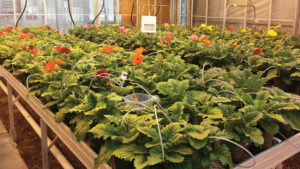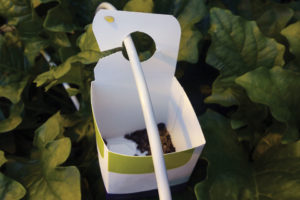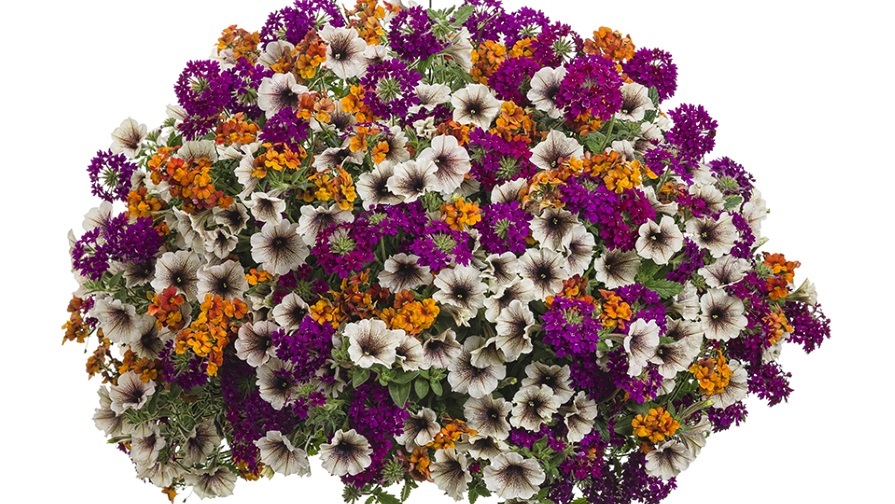How to Outfox Foxglove Aphids in the Greenhouse

Make scouting your crops a regular practice. Walk through crops looking for signs of aphids such as honeydew, white-cast skins, and rolling of the leaves.
By Ashley Summerfield, Michelangelo La Spina, and Rose Buitenhuis
How many foxglove aphids do you want in your crop?
The answer is zero, right? It is impossible to prevent the presence of aphids completely; however, the good news is that isn’t necessary. Just because the customer has a threshold of zero doesn’t mean that you have to. It only means that aphid numbers need to remain low enough so as not to cause damage, and they need to be gone by the time the product ships.
Biocontrol Plus Reduced Chemical Applications Provide Effective Control for Less Money
In spite of a growing adoption of biocontrol in Canada, aphids are often treated primarily with chemical pesticides because of a belief that biological control isn’t effective. It’s true, biocontrol may not be able to eliminate aphids entirely, but it should be able to keep aphid populations low enough not to cause damage. Growers who use biocontrol as their primary pest management strategy against aphids report that they still need to apply pesticides at least twice per crop cycle to achieve a desired level of control. If we are able to reduce pesticide applications to one time or not at all, this represents substantial cost savings, particularly if a drench treatment is required.
Based on the conclusions drawn from three years of greenhouse and laboratory experiments, we optimized an Integrated Pest Management (IPM) strategy that will maintain aphid populations below a safe level, ensuring that the product is clean by the time of shipment, without affecting the bottom line.
We know what you’re thinking — just because it worked in an experiment doesn’t mean it will work in the real world. This is why we asked commercial growers in Ontario and Quebec to test these recommendations and give us feedback. These growers were able to maintain foxglove aphid populations low enough not to cause damage to the crops and reduced the number of sprays by 50% compared to previous years.
Four Steps to Keep Aphid Populations in Check
Whether you’re an experienced biocontrol user, or just getting started, the following key steps are necessary to achieve the most efficient and effective aphid control:
1. Scout the crop regularly. Detecting infestations early will dramatically improve an IPM program’s efficacy. Walk through the crop looking for honeydew, white-cast skins, and rolling of leaves. Pick up the plants — foxglove aphids typically infest the underside of leaves and often start colonizing lower leaves first.
2. When you detect the first aphids, release parasitoids. Make sure you have correctly identified the aphid species first. Parasitoids are very specific to which species they will attack and may have no effect if the aphid was misidentified. Out of the parasitoids available in North America for controlling foxglove aphids, Aphidius ervi is the most effective.
Releasing parasitoids before aphids arrive is not useful, since A. ervi will simply leave the greenhouse in search of prey, or die. However, it is important to release A. ervi as soon as aphids are detected since aphid populations can explode quickly. This is why regular scouting is so important.
Release A. ervi weekly in the greenhouse until the number of aphids starts to decline, and then reduce to every two weeks. Use supplementary food, such as honey, to maintain parasitoid populations in the greenhouse.
3. Support with biopesticides or predators. If aphid populations are increasing despite weekly releases of A. ervi, use non-chemical options to knock down aphid populations so as not to interfere with your biologicals.
Generalist predators such as Aphidoletes aphidimyza, brown lacewings, or lady beetles, while not very effective at managing aphids at low numbers, are voracious eaters that are excellent for cleaning up hot spots.
Biopesticides such as Met52 or Botanigard are good alternative spray options, especially when bios are not immediately available and the pest can become problematic if there is a wait. They need to contact the aphids to work, so make sure you get good coverage under the leaves where foxglove aphids like to hide.
4. Clean-up with pesticides before shipment. If you still have aphids once the product is almost ready to sell, now is the time to turn to chemical pesticides to ensure a clean product. Beleaf, Endeavour, and Enstar are good options for a final clean-up spray.
If you need to use a chemical pesticide earlier in the crop cycle, only use Beleaf or Endeavour. In our research, these chemicals’ negative effects on natural enemies were less severe compared to other chemicals tested. Enstar is not compatible with many natural enemies and it can interfere with the control of aphids and other pests.

Use supplementary food, such as honey to maintain parasitoid populations in the greenhouse.
More Tactics to Try
In addition to the steps above, here are several other strategies that can improve the control of any pest:
• Prevent pest entry from outside by screening vents
• Remove weeds from inside and outside the greenhouse to eliminate local aphid population sources
• Don’t over-fertilize — many insects may grow faster on heavily fertilized plants
• Cut your losses. It’s often less expensive in the long run to throw out a few heavily infested plants than to clean them up through biological or chemical means. Throwing away a couple of problem plants immediately before they spread can slow down an infestation in the greenhouse.
Now is the Time for Biocontrol
Canadian growers are leaders in the use of biocontrol. Demand for biocontrol against aphids has not been as crucial as with other pests since pesticides are available and effective. With impending changes to many registered pesticides on the horizon, this may not always be the case. Perhaps now is a good time to put biocontrol at the forefront of management strategies for all pests.
Note: For all (bio) pesticides, always check the label to see if the product can be used in your crop.
Michelangelo La Spina, Ph.D. led this project under contract as Research Associate, Biological Control at Vineland Research and Innovation Centre. His contract has since expired. Ashley Summerfield is Research Technician, Biological Control at Vineland Research and Innovation Centre. Rose Buitenhuis, Ph.D. is Research Scientist, Biological Control at Vineland Research and Innovation Centre.










